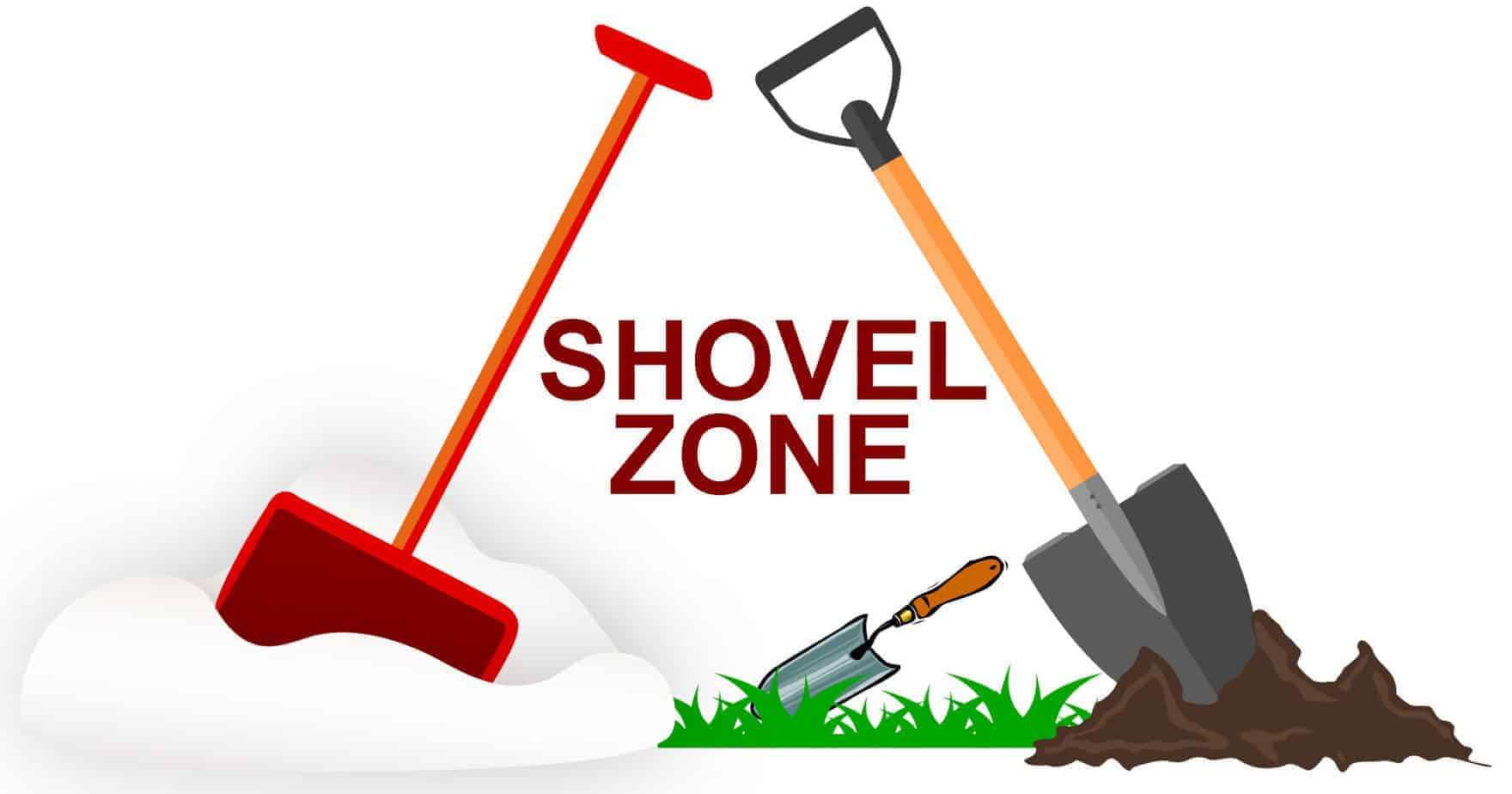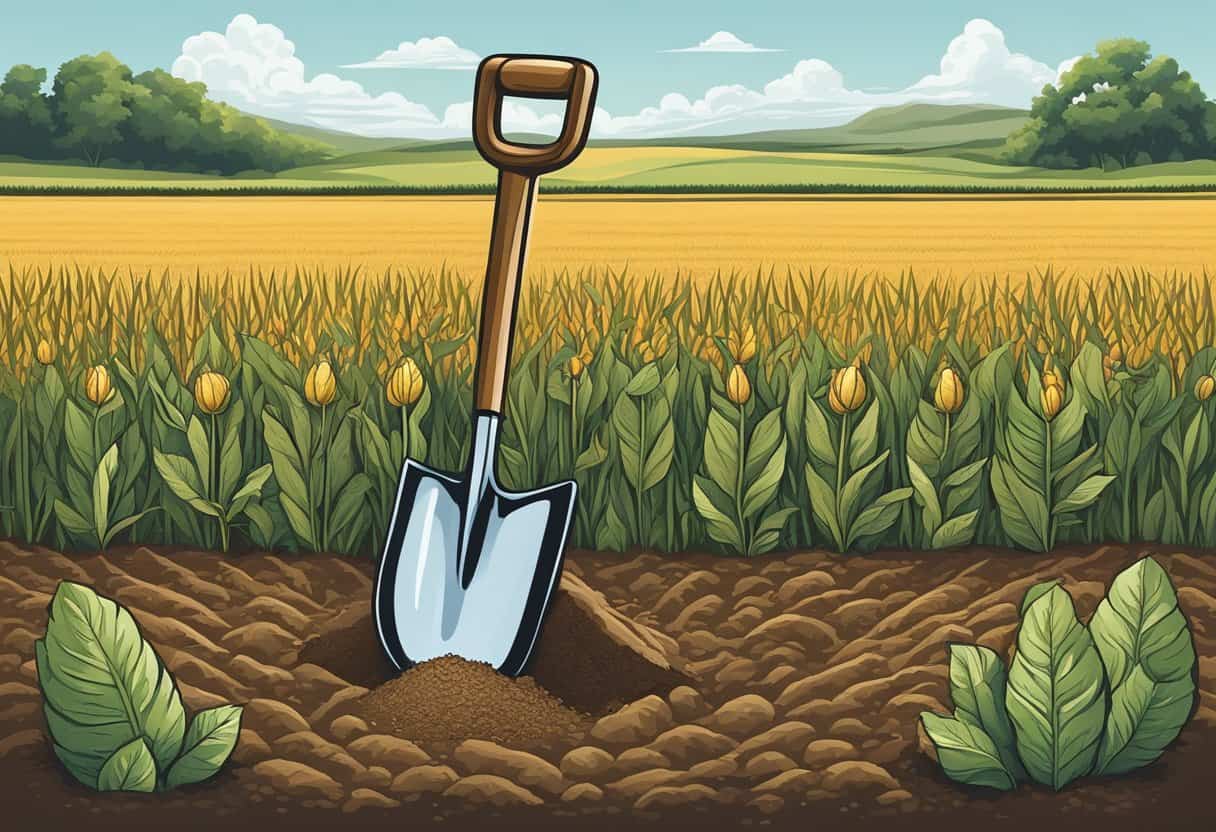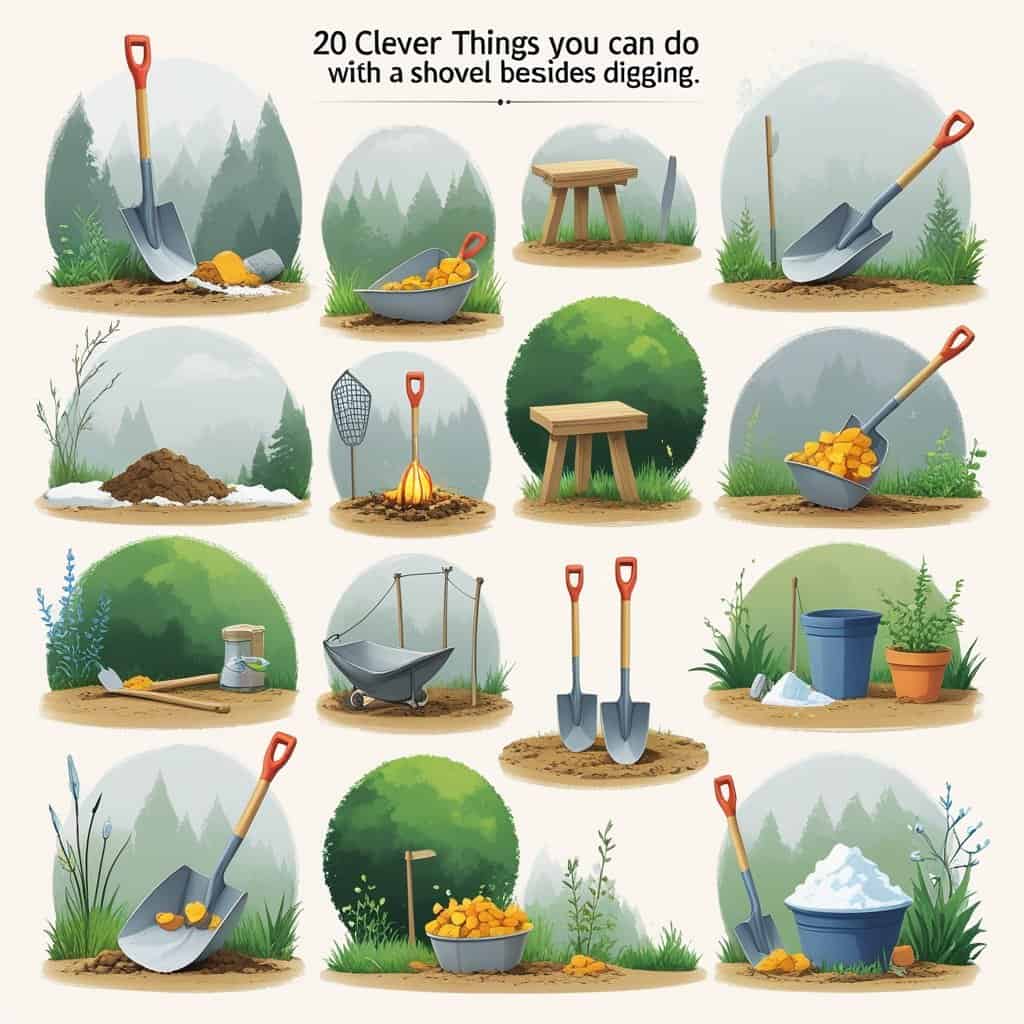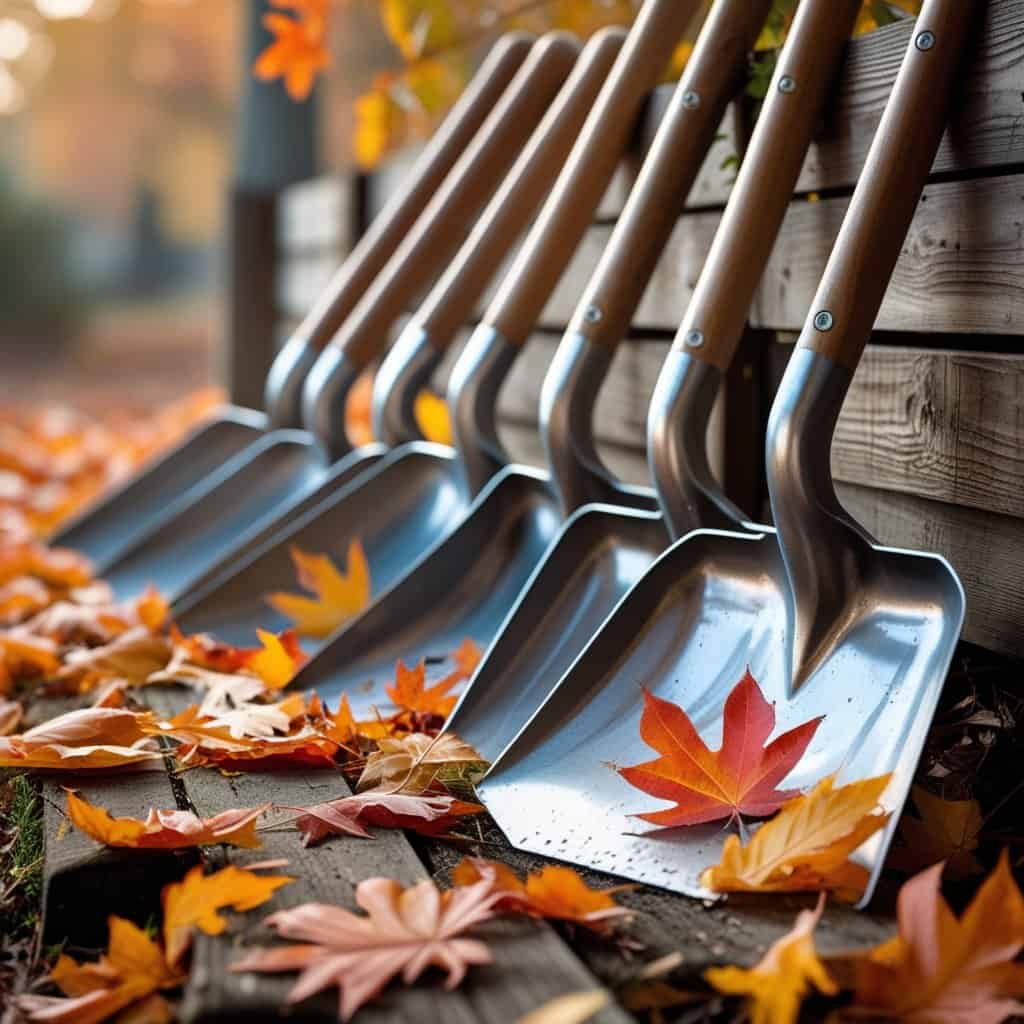Summer gardening can feel easier and more productive when we use the right shovel for the job. The right shovel saves time, reduces strain, and makes common tasks like digging, planting, and moving soil much more efficient.
With so many options available, it helps to know which tools fit best for summer projects.
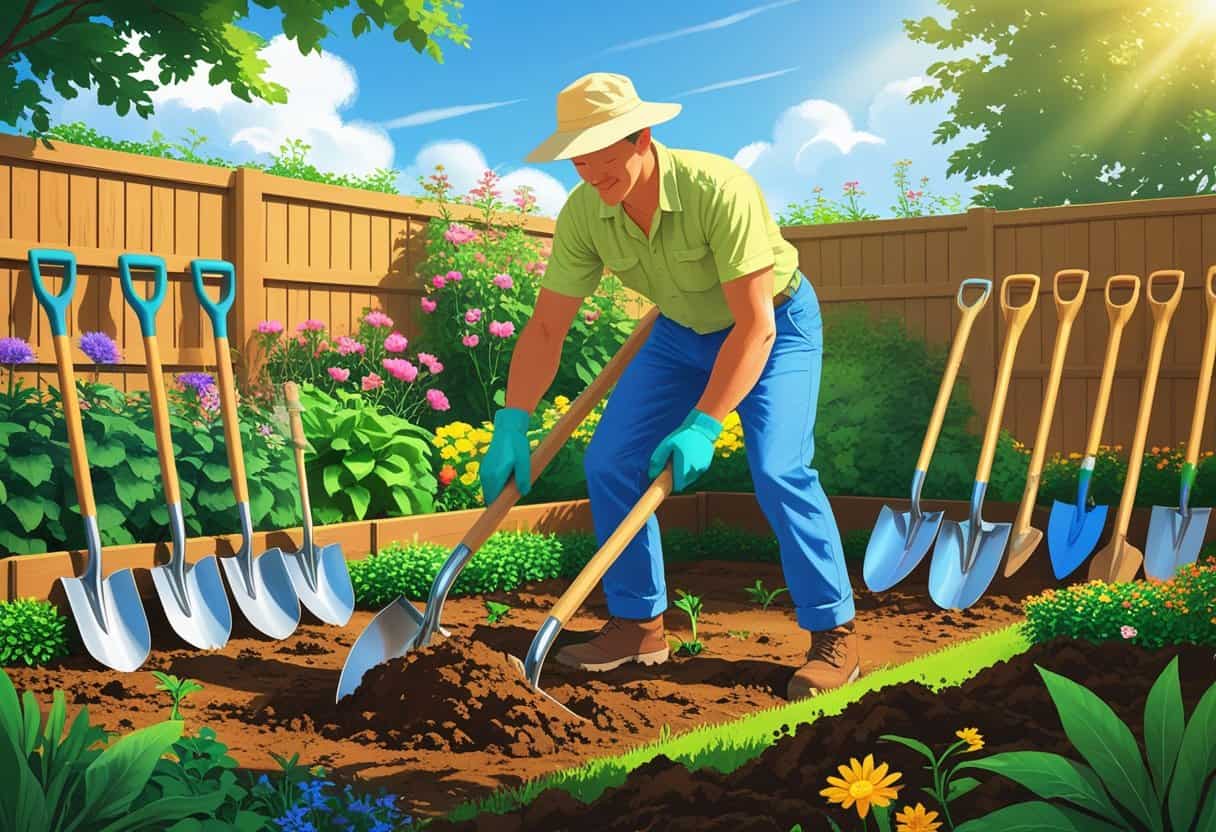
We often think of a shovel as a simple tool, but design, size, and materials make a big difference. A sturdy D-handle model can give us control in tight garden beds, while a folding or lightweight option works well when we need portability.
By understanding the features that matter most, we can choose tools that match our specific gardening needs.
Table of Contents
Choosing the Right Shovel for Summer Gardening
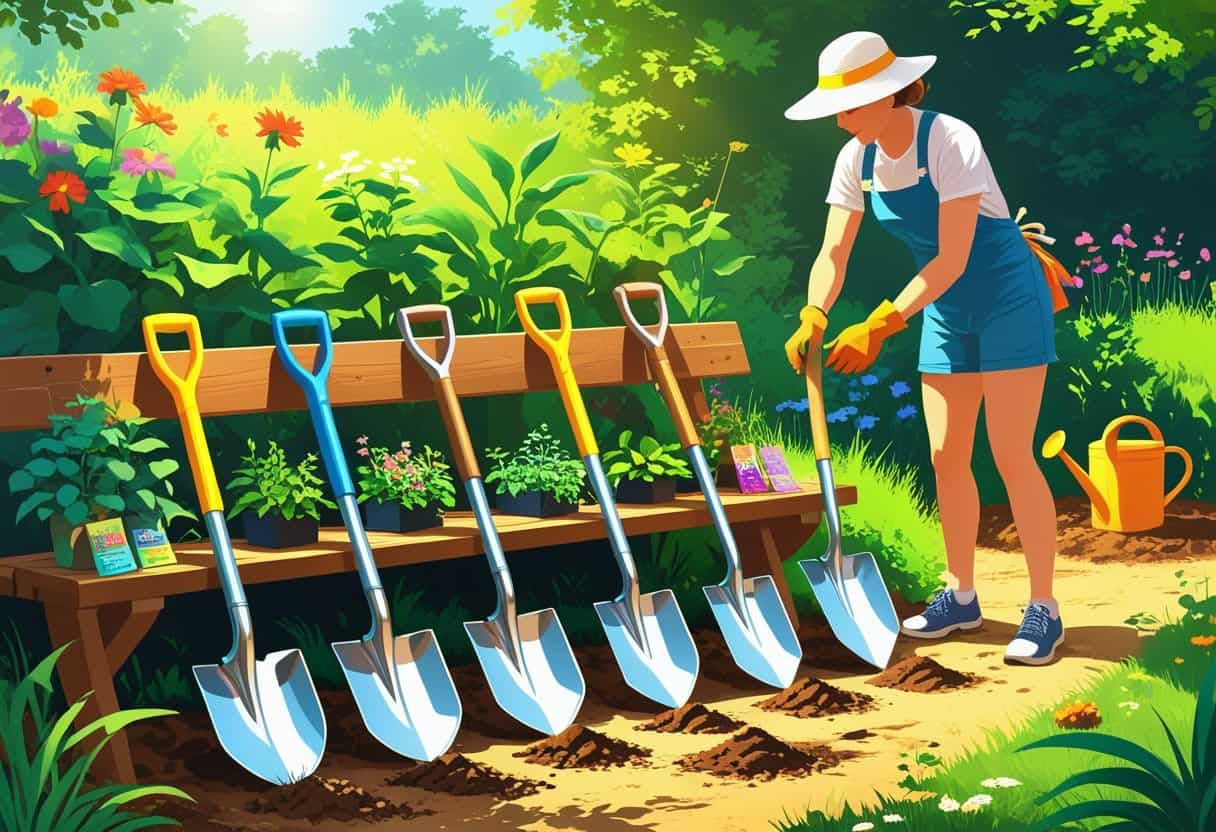
We need to match the right garden shovel to the type of work, soil condition, and materials we handle. A good fit reduces strain, improves efficiency, and helps us care for our garden without unnecessary effort.
Assessing Your Gardening Needs
Before buying or using a shovel, we should think about the main tasks we face. Digging planting holes, moving mulch, edging beds, or trenching all require different tools.
A single shovel may not handle every job well. Soil type matters too.
Loose, sandy soil is easy to dig with a lighter blade, while clay soil needs a stronger and sharper edge. If we move compost, gravel, or mulch often, a flat or scoop-style shovel saves time compared to a digging blade.
We also need to consider our physical comfort. Taller gardeners benefit from longer handles, while shorter handles give better control in tight spaces.
Choosing the right handle length prevents back strain during long summer days in the garden.
Shovel Types and Their Uses
Different shovel designs serve specific purposes. A round-point shovel is the most common and works best for digging and breaking compacted soil.
A square-point shovel handles loose material like soil, mulch, or compost with ease, as noted in the Healthy Gardening Guide.
For narrow spaces or trenching, a trenching shovel cuts clean lines and digs deeper channels. A scoop shovel moves large amounts of lightweight material, such as leaves or wood chips.
Smaller hand trowels help with precise planting in containers or flower beds. Using the right type keeps us from forcing a tool to do work it was not designed for.
This increases efficiency and extends the life of our gardening tools.
Key Features for Summer Performance
Summer gardening often means heat, dry soil, and frequent use. We should look for shovels with sturdy steel blades that resist bending and stay sharp.
Fiberglass handles are durable and lighter than wood, making them easier to use in hot weather. A D-handle grip provides better control when lifting or scooping, especially with heavy soil or gravel.
Long handles reduce bending and protect our backs during repetitive digging. The Prudent Garden guide highlights how handle length directly affects comfort and efficiency.
Weight also plays a role. A lighter shovel helps us work longer without fatigue, but it should still be strong enough to handle tough soil.
Choosing the right balance of strength and comfort allows us to work more effectively in summer conditions.
Types of Shovels for Summer Tasks
When we choose the right shovel, we save time, protect our energy, and get cleaner results in the garden. Different shovel types serve specific purposes, from digging compacted soil to moving large amounts of mulch or gravel.
Round Point Shovel Benefits
A round point shovel is one of the most versatile garden shovels we can own. Its curved blade with a pointed tip makes it effective for digging into compacted or rocky soil.
The tip slices into the ground, while the rounded edges help lift and turn soil with less strain. We often rely on this shovel for planting shrubs, moving dirt, or shaping garden beds.
The blade design allows us to dig deeper holes than a flat shovel, especially in tougher soil conditions. Many round point shovels come with a long handle for leverage or a D-grip handle for better control.
Choosing the right handle length depends on our height and the type of task. A longer handle works best for digging, while a D-handle provides more precision.
For general-purpose gardening, the round point shovel is considered the most adaptable option.
Scoop Shovel Applications
A scoop shovel has a wide, deep blade designed for moving loose materials. Unlike a digging shovel, it is not meant for cutting into soil.
Instead, we use it to handle mulch, compost, gravel, or even snow in colder months. The large blade surface lets us carry more material with each load.
This makes it ideal when we need to spread mulch across flower beds or transfer soil into a wheelbarrow. Scoop shovels often come with lightweight aluminum or plastic blades.
These materials reduce fatigue during repetitive lifting. However, steel versions are available for heavier materials like gravel.
Because of its design, a scoop shovel is not a digging tool. Instead, it complements our garden shovels by taking over the heavy lifting and moving tasks.
The scoop shovel is especially useful during summer landscaping projects when we need efficiency in moving bulk materials.
Specialized Shovels for Unique Tasks
Certain summer jobs call for specialized shovels that make tasks easier and more precise. For example, an edging shovel creates clean lawn borders, while a trenching shovel digs narrow channels for irrigation lines.
A post hole shovel or digger is essential when setting fence posts or building garden structures. Its twin blades grip and lift soil in a cylindrical shape, leaving a neat hole with minimal effort.
For small-scale planting, a handheld garden shovel (or trowel) helps us dig holes for flowers or vegetables. These compact tools are perfect for container gardening or working in tight spaces.
Other unique designs include root shovels with serrated edges that cut through tough roots. Each of these tools serves a specific purpose, saving us time and reducing strain when compared to using a general-purpose shovel.
A wide range of specialized garden shovels ensures we can match the right tool to the right task.
Essential Shovel Features and Materials
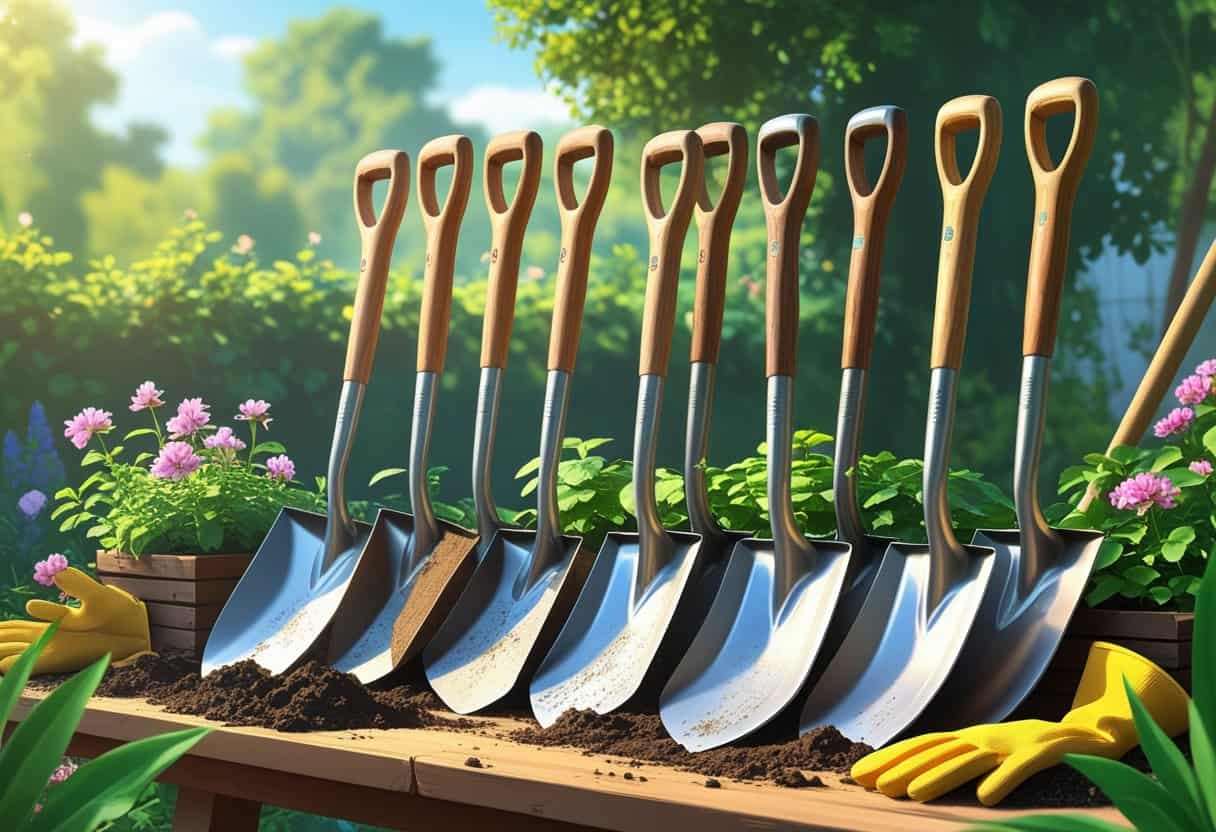
When we choose a shovel for summer gardening, we need to look closely at how the blade is built, what materials the handle uses, and how the tool feels in our hands. These details affect how long the shovel lasts, how much effort we use, and how comfortable it is during long tasks.
Blade Construction and Durability
The blade is the part of the shovel that takes the most stress. A strong blade helps us dig into soil, move mulch, or cut through roots without bending or breaking.
Most quality blades are made from hardened steel, which resists wear and keeps its edge longer. Some blades are pointed for digging, while others are flat for edging or scooping.
For example, a round point blade works best for breaking into compact soil, while a scoop shovel is better for moving loose materials like mulch or snow. Choosing the right blade shape saves us time and energy.
We should also look at how the blade is attached to the handle. A solid socket connection or a riveted joint usually lasts longer than a simple press fit.
Brands like Bully Tools focus on reinforced designs that reduce the risk of breakage, which makes them a reliable choice for heavy use.
Handle Materials: Fiberglass vs. Wood
The handle material changes how the shovel feels and how long it lasts. Wood handles, often made from ash or hickory, give a natural grip and some flexibility.
They are comfortable but may crack or splinter if left in wet conditions. Fiberglass handles are lightweight and resist weather damage.
They do not warp or rot, which makes them a good option for year-round use. Some fiberglass models also include a cushioned grip for added control.
We should match the handle to the type of work we do. For frequent digging in tough soil, fiberglass holds up better.
For lighter gardening tasks where comfort matters more, wood handles may be the right fit. Many modern shovels, such as those from Garant, offer both styles to meet different needs.
Ergonomics and Comfort
Comfort matters when we spend hours in the garden. A shovel that fits our body reduces strain and helps us work longer without fatigue.
Handle length plays a big role—shorter handles give more control in tight spaces, while longer handles reduce bending. We should also look at the shape of the grip.
A D-shaped grip makes lifting and scooping easier, especially with heavy loads. Straight grips are lighter but may not provide as much leverage.
Some shovels include ergonomic bends in the handle to keep our backs straighter while digging. These designs can reduce stress on the lower back and shoulders.
By paying attention to these features, we can select a shovel that not only performs well but also protects our bodies during repeated use.
Best Practices for Using Shovels in Summer Gardening
We get the most out of our garden shovels when we match the right technique with the right task. Simple habits like proper digging depth, lifting lighter loads, and keeping tools clean help us work more efficiently and avoid strain.
Digging and Planting Techniques
When digging, we should choose the right shovel blade for the soil. A round-point shovel works best in loose or soft soil, while a spade with a flat edge cuts clean lines for edging or transplanting.
According to Garden Tools Expert, blade shape and grip design directly affect how safe and effective we are when working. For planting, we should angle the shovel slightly to loosen soil without damaging roots.
In compacted ground, stepping on the top edge of the blade gives us more force. A trowel or small hand shovel is better for seedlings, while a full-size shovel is suited for trees or shrubs.
To reduce fatigue, it helps to bend our knees and use our legs instead of our back. Short, controlled motions are safer than forcing the blade deep with one heavy push.
This approach keeps us steady and prevents injury during long gardening sessions.
Moving Mulch and Soil Efficiently
When spreading mulch or soil, a scoop shovel or wide-bladed shovel saves time. These tools hold more material than a narrow blade, which makes them ideal for covering beds or filling wheelbarrows.
Using the right shovel type improves efficiency and reduces the number of trips we need to make. We should avoid overloading the shovel.
Lighter, repeated scoops move material faster than lifting one heavy load. For tasks like mulching, it is often easier to shovel material into a wheelbarrow first, then spread it evenly across the garden beds.
Keeping piles close to the work area also reduces wasted effort. As Gardening Know How notes, choosing the right shovel for each job makes the work smoother and helps us avoid unnecessary strain.
Maintaining Your Shovel Tools
A well-maintained shovel lasts longer and works better. After each use, we should rinse off soil and mulch, then dry the blade to prevent rust.
A quick wipe with a light oil on the metal keeps it from corroding, especially in humid summer weather. Handles also need care.
Wooden handles benefit from sanding rough spots and applying linseed oil to prevent cracking. Fiberglass handles require less upkeep but should still be checked for splits or wear.
Sharpening the blade edge once or twice a season makes digging easier. Storing tools in a dry shed or garage keeps them ready for the next gardening task.
Recommended Shovel Brands and Models
When choosing garden shovels, we should focus on strength, comfort, and how well the tool handles different tasks. Some models stand out for their durability, while others are lighter and easier to use over long periods.
Top Picks for Durability and Performance
We find that steel-handled shovels last longer than fiberglass or wood. For example, the Fiskars Steel D-handle Digging Shovel offers a hardened steel blade and shaft, making it one of the most durable options for heavy digging.
Its wide step platform also reduces strain by letting us use our legs instead of just our arms. Fiberglass handles, while lighter, do not match steel for toughness.
The Bully Tools 82525 Square Point Shovel uses a reinforced fiberglass design, giving it a balance of strength and reduced weight. Its closed-back blade also prevents soil from sticking, which saves effort during repetitive scooping.
For trenching, the Truper 33436 Trench Shovel stands out with a narrow steel blade and cushioned grip. This design makes it easier to dig defined trenches for drainage without adding too much weight.
Quick comparison of durable picks:
| Model | Handle Material | Weight | Best Use |
|---|---|---|---|
| Fiskars D-handle | Steel | 5 lbs | General digging |
| Bully Tools 82525 | Fiberglass | 4.9 lbs | Scooping, leveling |
| Truper 33436 | Fiberglass | 3.3 lbs | Trenching |
Comparing Leading Garden Shovel Brands
Among shovel brands, Fiskars often leads in steel construction and ergonomic design. Their transfer and digging shovels combine rust-resistant blades with comfortable grips, making them reliable for frequent garden work.
Bully Tools focuses on American-made fiberglass-handled shovels. Their square point models are especially good for moving mulch or shaping beds.
Truper offers a wide range of specialty shovels, including trench and drain spades. These models use rivetless collars and reinforced fiberglass to extend tool life.
Gardeners who need tools for specific jobs, such as drainage, may find Truper’s lineup practical. For compact spaces, smaller steel models like the Z & G Mini Shovel provide portability and rust resistance.
While not suited for heavy digging, they fit well in tight spots or for light-duty projects. We can explore more detailed reviews of top-rated garden shovels through LawnStarter’s guide and other expert comparisons.
Frequently Asked Questions
We often get asked about which shovel works best for summer gardening, how to match tools to soil conditions, and how to keep them in good shape.
What are the essential shovel types for effective summer gardening?
We rely on a few basic shovel types for most summer tasks. A round point shovel helps with digging and planting, while a square point shovel works well for moving soil or compost.
A scoop shovel is useful when handling lighter materials like mulch.
How do I choose the right shovel for different soil types?
Soil texture matters when picking a shovel. For clay or compact soil, a pointed tip shovel cuts through more effectively.
Sandy or loose soil is easier to manage with a flat or square blade.
What is the proper way to maintain and store garden shovels?
We clean blades after each use to prevent rust. Storing shovels in a dry place keeps moisture from damaging the metal.
A light coat of oil on the blade and handle helps extend their lifespan.
Can you recommend ergonomic shovels for long gardening sessions?
Ergonomic shovels often have curved handles or padded grips to reduce strain. Some models feature lightweight materials that make them easier to use over time.
These designs help us work longer without discomfort.
What are the differences between spades and shovels when preparing garden beds?
A spade has a flat, straight blade that makes it better for edging and slicing through soil. A shovel has a curved blade, which allows us to dig and lift soil more efficiently.
Both tools serve important but different purposes when shaping beds.
How do I sharpen garden shovels for optimal performance?
We use a metal file to sharpen the edge of the blade. Filing at a consistent angle keeps the edge even and effective.
Regular sharpening ensures the shovel cuts into soil cleanly. This reduces the effort needed.
